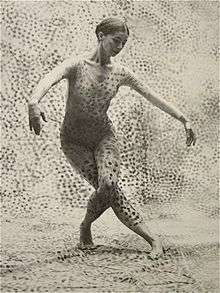Viola Farber
| Viola Farber | |
|---|---|
 Farber performing in Summerspace (1958) | |
| Born |
February 25, 1931 Heidelberg, Germany |
| Died |
December 24, 1998 (aged 67) Bronxville, New York |
| Occupation | Dancer, choreographer |
Viola Farber (February 25, 1931 – December 24, 1998) was an American choreographer and dancer.
Biography
Viola Farber was born on February 25, 1931 in Heidelberg, Germany.[1] In Germany, Farber began dancing. However, at the age of six she was told by her parents, “No, you cannot do this anymore”. At the age of seven, Farber and her family moved to the United States. Even though her parents did not allow her to dance, Farber continued dancing on her own, though she focused more of her energy on learning to play the piano. During the one year that Farber spent at the University of Illinois studying music, she began taking dance classes from Margaret Erlanger.[2] When Farber transferred to George Washington University, she focused on both music and dance. By 1952, Farber had transferred once again, to Black Mountain College was dance with Katherine Litz and music with Lou Harrison.
In 1953, Farber became a founding member of the Merce Cunningham Dance Company. She created many roles in Cunningham’s works, such as Crises, Paired Rune, and Nocturne. Farber is described as being “one of the great individualists of the company”.[1] At this time, she also took various dance classes from Margaret Craske and Alfred Corvino in New York, and from Erika Thimey in Washington, D.C. Additionally, Farber was dancing with other choreographers. She performed the role of the vampire in Litz’s Dracula as well as dancing with Paul Taylor’s early company. Farber was the only female pianist in Erik Satie’s (organized by John Cage) twenty-four-hour performance of Vexations.[1] In 1965, she left Cunningham’s company and in 1968, began her own company.
Viola Farber’s Dance Company and style
Through having her own dance company, The Viola Farber Dance Company, Farber was able to develop her own dance style. She often used improvisation in her rehearsals and in some of her first works.[1] She allowed her dancers to rearrange and reshape the movement, however she set explicit limits. Her dancers were allowed to do whatever they wanted ”.[2] Farber would almost ask dancers to manipulate the phrase and provided cues for beginning different sections. Although, these cues were never related to the music. Jeff Slayton, a member of the company and Farber’s longtime partner, comments that “if a dance had internal or set musical cues, we changed the music”.[2] Her work challenged audiences and was often found compelling. The pieces Poor Eddie (1973) and Willi I (1974) were described as sadomasochistic, while No Super, No Boiler (1974) and Lead Us Not into Penn Station (1975) had humorous themes, and Dune and Nightshade (both choreographed in the early 1970s) had quiet themes.[1] Most of the Farber’s pieces were set to original scores, or were performed in silence. However, a few of her pieces were choreographed to classical music. For example, Nightshade was set to Beethoven’s Piano Sonata No. 14.[1]
Farber died on December 24, 1998 in Bronxville, New York.[1]
Notable projects
- 1970s: Brazos River, video collaboration with Robert Rauschenberg and David Tudor[1]
- 1974: Made cite specific dances at the Bronx Botanical Gardens and in the Staten Island Ferry waiting room.[1]
- Sunday Afternoon (1976) and Private Relations (1979): Farber choreographed these works with a more relaxed feel.[1]
Teaching career
- Adelphi University (1959–1967) [1]
- Cunningham Studio (1961–1969) [1]
- Bennington College (1967–1968) [1]
- Appointed by French government to artistic director of Centre National de Danse Contemporiane in Angers (1981–1983) [1]
- Sarah Lawrence College Director of Dance Department (1988–1998)
References
- Caines, Christopher (1998). "Viola Farber". International Encyclopedia of Dance (e-reference ed.). Oxford University Press, Inc. Retrieved 2009-04-05.